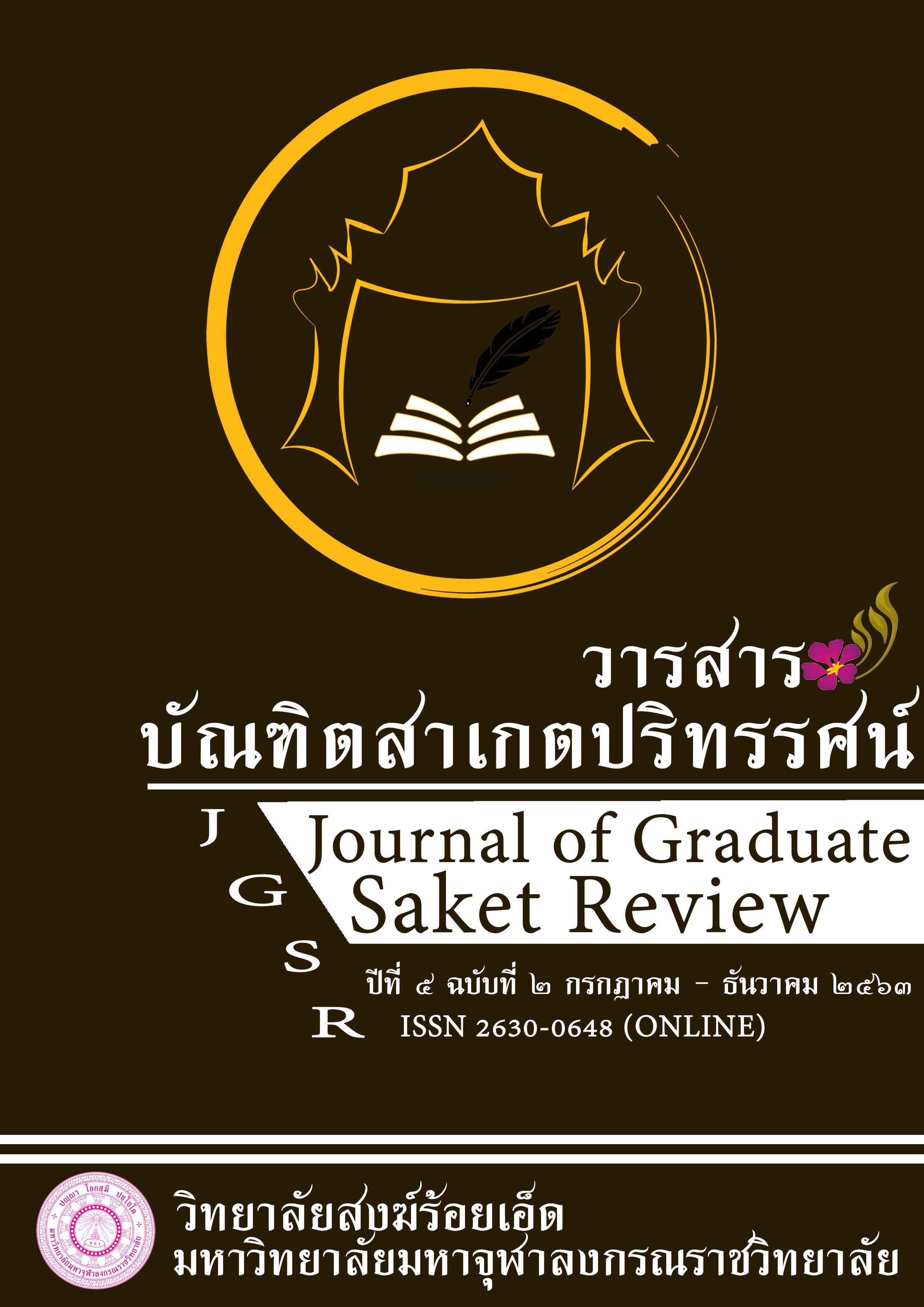ธรรมาธิปไตย : เกณฑ์มาตรฐานแห่งความดีงาม
Main Article Content
บทคัดย่อ
การนำหลักเกณฑ์ว่าด้วยเรื่องของความดีความชั่วมาตัดสินการปฏิบัติตนของคนในสังคม เพื่อให้เป็นมาตรฐานและเป็นที่ยอมรับในสังคมทั่วไปนั้น ผู้เขียนมีความเห็นว่า หลักธรรมาธิปไตยมีความเหมาะสมกับการเป็นเกณฑ์มาตรฐานแห่งความดีงามมากที่สุด เพราะธรรมาธิปไตยเป็นการถือธรรมเป็นใหญ่ ปรารภความถูกต้องสมควรตามธรรมเป็นประมาณ โดยมีวิธีพิจารณาว่า การกระทำนั้นเป็นคุณหรือโทษต่อชีวิตรวมไปถึงจิตใจและบุคลิกภาพ เป็นคุณหรือโทษต่อบุคคล เป็นคุณหรือโทษต่อสังคมตามมโนธรรมและมาตรฐานทางสังคม แม้ว่าในสังคมปัจจุบันเป็นสังคมประชาธิปไตย ให้การยอมรับเรื่องของสิทธิ เสรีภาพ และความเสมอภาคสังคมจึงให้ความสำคัญกับเสียงของคนส่วนใหญ่เป็นหลักแต่เราจะต้องยอมรับว่าความเห็นของคนส่วนใหญ่ไม่สามารถการันตีได้ว่าเป็นความเห็นที่ถูกต้องเสมอไปเพราะความเห็นนั้นเป็นเพียงการวัดในแง่ความต้องการของคนส่วนใหญ่ไม่สามารถชี้วัดความดีความชั่วได้
ความเห็นของคนส่วนใหญ่จึงไม่ใช่เกณฑ์ตัดสินความดีความชั่วที่ถูกต้องที่สุด การชี้วัดความดีความชั่วจะต้องอาศัยธรรมมาเป็นเครื่องกำกับ ดังนั้นทำอธิปไตยจึงเป็นเกณฑ์มาตรฐานเป็นความดีงาม อันจะก่อให้เกิดความสามัคคีปรองดองสมานฉันท์ในสังคมและประเทศชาติ ซึ่งมีวิธีการคือเราจะต้องใช้กระบวนการการพิจารณาถึงคุณและโทษต่อตนเองผู้อื่นและสังคมรวมถึงการพิจารณาโดยมโนสำนึกและมาตรฐานทางสังคมโดยยึดธรรมาธิปไตยเป็นที่ตั้ง
Article Details
เนื้อหาและข้อมูลในบทความที่ลงตีพิมพ์ในวารสารบัณฑิตสาเกตปริทรรศน์ ถือเป็นข้อคิดเห็นและความรับผิดชอบของผู้เขียนบทความโดยตรงซึ่งกองบรรณาธิการวารสาร ไม่จำเป็นต้องเห็นด้วย หรือร่วมรับผิดชอบใด ๆบทความ ข้อมูล เนื้อหา รูปภาพ ฯลฯ ที่ได้รับการตีพิมพ์ในวารสารบัณฑิตสาเกตปริทรรศน์ ถือเป็นลิขสิทธิ์ของวารสารบัณฑิตสาเกตปริทรรศน์ หากบุคคลหรือหน่วยงานใดต้องการนำทั้งหมดหรือส่วนหนึ่งส่วนใดไปเผยแพร่ต่อหรือเพื่อกระทำการใด ๆ จะต้องได้รับอนุญาตเป็นลายลักอักษรจากวารสารบัณฑิตสาเกตปริทรรศน์ ก่อนเท่านั้น
References
กรมการศาสนา. การทรวงศึกษาธิการ.(2525) พระไตรปิฎกภาษาไทย ฉบับหลวง. เล่มที่ 9,10,15,20.กรุงเทพมหานคร : โรงพิมพ์มหามกุฎราชวิทยาลัย.
คูณ โทขันธ์.(2545). พุทธสาสนากับสังคมและวัฒนธรรมไทย. กรุงเทพมหานคร:โอเดียนสโตร์
เดือน คำดี.(2530). ปัญหาปรัชญา. กรุงเทพมหานคร:โอ.เอส.พริ้นติ้งเฮาส์.
ติช นัทฮันห์.(2533). ศิลปะแห่งอำนาจ. แปลโดย จิตร์ ตัณฑเสถียรและสังฆะหมู่บ้านพลัมประเทศไทย. พิมพ์ครั้งที่ ๕. กรุงเทพมหานคร:สำนักพิมพ์ฟรีมายด์.
ปรีชา ช้างขวัญยืน.(2538). ความคิดทางการเมืองในพระไตรปิฎก. พิมพ์ครั้งที่ 2. กรุงเทพมหานคร:จุฬาลงกรณ์มหาวิทยาลัย.
พระธรรมปิฎก (ป.อ.ปยุตฺโต).(2542). พุทธธรรม ฉบับปรับปรุงขยายความ. กรุงเทพมหานคร: มหาจุฬาลงกรณมหาวิทยาลัย.
พระธรรมปิฎก (ป.อ.ปยุตฺโต). (2542). ธรรมกับไทยในสถานการณ์ปัจจุบัน.กรุงเทพมหานคร:มูลนิธิพุทธธรรม.
พระธรรมปิฎก (ป.อ.ปยุตฺโต). (2545). พจนานุกรมพุทธศาสตร์ ฉบับประมวลธรรม. พิมพ์ครั้งที่ 11.กรุงเทพมหานคร:สหธรรมิก.
พระเมธีธรราภรณ์(ประยูร ธมฺมจิตฺโต).(2536). เปรียบเทียบความคิดพุทธทาส-ซาร์ต.กรุงเทพมหานคร:สำนักพิมพ์ศยาม.
พระราชญาณวิสิฐ (เสริมชัย ชยมงฺคโล). (2552). พระพุทธศาสนา ศาสนาประจำชาติไทย. พิมพ์ครั้งที่ 1.กรุงเทพมหานคร : มหาจุฬาลงกรณราชวิทยาลัย.
พระราชญาณวิสิฐ (เสริมชัย ชยมงฺคโล). (2548) . ธัมมิกสังคมนิยม. กรุงเทพมหานคร:สุขภาพใจ.
มหาวิทยาลัยสุโขทัยธรรมาธิราช.(2548). พื้นฐานทางสังคมและวัฒนธรรมของการเมืองไทย.นนทบุรี :สำนักพิมพ์มหาวิทยาลัยสุโขทัยธรรมาธิราช.
ราชบัณฑิตยสถาน,(2554), ภาษาไทย-พจนานุกรม. พิมพ์ครั้งที่ 2. กรุงเทพมหานคร: นานมีบุ๊คส์พับลิเคชั่นส์.
ว.วชิรเมธี.(2551). ยศ ทรัพย์ อำนาจ เป้าหมายหรือมรรควิธีของชีวิต. กรุงเทพมหานคร:บ้านพระอาทิตย์.
สุธรรม ชูสัตย์สกุล.(2545). เอกสารประกอบการบรรยายปรัชญาเปรียบเทียบ. กรุงเทพมหานคร : มหามกุฎราชวิทยาลัย.

